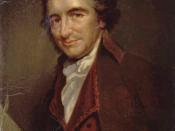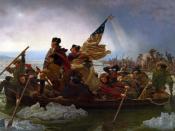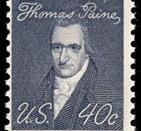Thomas Paine, often called the "Godfather of America" was an eighteenth century writer who used propaganda and persuasion techniques to motivate Americans in the fight for freedom from Britain. In one of several editions of his pamphlets titled The Crisis, Paine used several propaganda and persuasion techniques including over generalization, either/or fallacy, bandwagon appeal, parallelism, analogy, repetition, anecdote, and loaded language. During the winter of 1776, American soldiers fighting in the Revolutionary War under the command of George Washington had little food, insufficient shelter, and many were deserting. The reading of The Crisis to these troops had a profound effect upon their morale which lead to a victory at Trenton. George Washington's famous crossing of the Delaware River ultimately became a turning point in the war. As noted by John Keane in his book, Tom Paine: a Political Life, "Tom Paine strikes our times like a trumpet blast from a distant world."
Thomas Paine used propaganda methods to induce a desire for freedom in the reader in one of his works, The Crisis. One type of propaganda used was over generalization. His use of broad generalities was demonstrated when he concluded, "Not a man lives on the continent, but fully believes that a separation must sometime or other finally take place..." A second type of propaganda used was either/or fallacy. Paine had the sentiment that a man either fought for freedom or would always be known as a coward when he stated, "The heart that feels not now is dead; the blood of his children will curse his cowardice who shrinks back at a time when a little might have saved the whole, and made them happy." The third and final use of propaganda in Paine's The Crisis was the bandwagon appeal. To truly be an...


